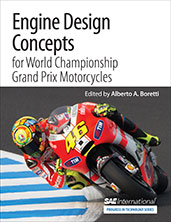Technical Paper
A Novel Valve-Less Supercharged Small Two Stroke Engine of Top Brake Efficiency Above 36% and Power Density above 100 KW/Liter
2013-11-27
2013-01-2772
The paper presents a novel design for a two stroke thermal engine that delivers excellent fuel economy and low emissions within the constraints of today's cost, weight and size. The engine features asymmetrical port timing through a novel translating and rotating piston mechanism. The engine is externally scavenged and supercharged, has wet sump and oil pressure lubrication, direct injection, it is lightweight, easy to build, with minimal number of parts, low production cost, ability to be balanced and compact design. The two stroke mechanism produces a linear motion of the pistons as well as an elliptical path on the surface of the cylinder. This allows the piston to sweep as well as travel past the ports. Suitable slots around the raised lip of the piston generate the asymmetry that makes the exhaust port to open first and to close first. The inlet port remains open to complete the cylinder charging and allow supercharging. Direct fuel injection is adopted for best results.

